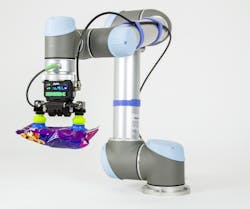The Cobots are Coming
Most industrial robots must work in enclosed work stations to keep people out. If someone does come in, an interlock shuts the robot down to prevent it from harming anyone. An alternative has been to use light screens and sophisticated proximity and motion detectors—again, to prevent a robot from striking anyone while it is performing its task.
The newest robots are collaborative robots, also known as cobots. They are designed to work (collaborate) with humans. Rather than stop working, they use sophisticate sensing systems to work alongside humans. So even though the robot itself may work safely around humans, gripping a workpiece can still be a challenge. That’s one reason why vacuum grippers are widely used with cobots: Vacuum avoids pinch points that otherwise occur between a gripper’s fingers and a work piece.
Piab, Hingham, Mass., recently introduced piCOBOT system, an end-of-arm vacuum tool designed specifically for use with cobots. It uses Piab’s vacuum multi-stage vacuum generators and industry-certified plug-and-play extensions to the latest cobots. And Piab officials say the piCOBOT’s end-of-arm-tool is designed to fit any type of cobot arm.
Offered as a development kit, piCOBOT comprises a vacuum pump unit, a gripper unit, and vacuum suction cups. The standard kit includes four different sets of suction cup models suitable for a variety of tasks, but users can also choose freely from the company’s extensive range of suction cups for more specific setups.
Fitted with a pair of vacuum cups, Piab’s piCobot is shown here lifting a lightweight package of snack food—although it can handle objects weighing more than 15 lb.
Certified by Universal Robots, piCOBOT builds on the idea of safe and flexible human-robot workplace interaction, found to be much more productive than either of them working on their own. Soft design lines guarantee that no one is injured if colliding with piCOBOT.
PiCOBOT’s 3.8- to 5.6-in. wide and ±15 deg. tiltable gripper arms can be fitted with two suction cups. Alternatively, the gripper can be replaced by a single suction cup mount directly onto the piCOBOT vacuum generator. For optional single- or double-object picking, dedicated sensing valves ensure safe operation regardless of mode.
Although a compact format and low build height of 2.7 in. allow use in tight spaces, piCOBOT’s light weight offers a great advantage compared to alternative solutions. PiCOBOT weighs only 18 oz., and the gripper only adds another 7.4 oz. Yet, piCOBOT can lift objects weighing up to 15½ lb. This provides maximum payload capacity for the cobot,” explains Josef Karbassi, vice president of Piab’s Automation Div. “We have selected features that enable energy-optimized and safe operation to make piCOBOT a genuinely flexible and user-friendly cobot end-of-arm tool.”
For more information, call Piab at (800) 321-7422, or visit the company's website.



